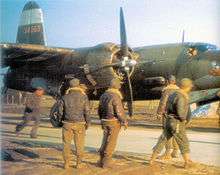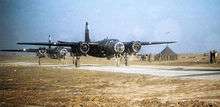Earls Colne Airfield
| Earls Colne Airfield RAF Earls Colne USAAF Station AAF-358 .png)  | |||||||||||
|---|---|---|---|---|---|---|---|---|---|---|---|
|
Postwar RAF aerial photo of Earls Colne Airfield - 9 July 1946 just after its closure. | |||||||||||
| IATA: none – ICAO: EGSR | |||||||||||
| Summary | |||||||||||
| Airport type | Public | ||||||||||
| Operator | Bulldog Aviation Ltd | ||||||||||
| Serves | Halstead | ||||||||||
| Location | Earls Colne | ||||||||||
| Elevation AMSL | 227 ft / 69 m | ||||||||||
| Coordinates | 51°54′52″N 000°40′57″E / 51.91444°N 0.68250°ECoordinates: 51°54′52″N 000°40′57″E / 51.91444°N 0.68250°E | ||||||||||
| Map | |||||||||||
 EGSR Location in Essex | |||||||||||
| Runways | |||||||||||
| |||||||||||
Earls Colne Airfield (ICAO: EGSR) is a former Royal Air Force station in Essex, England. Earls Colne has a CAA Ordinary Use Aerodrome Licence (Number P860), issued to Bulldog Aviation Limited.[2] The airfield is located 3 nautical miles (5.6 km; 3.5 mi) southeast of Halstead, approximately 5 mi (8.0 km) east-northeast of Braintree; about 45 mi (72 km) northeast of London
Opened in 1942, it was used by both the Royal Air Force and United States Army Air Forces. During the war it was used primarily as a combat bomber airfield. After the war it was closed in 1955 after many years of being in a reserve status.
Much of the airfield today is being used as a golf course. A flying club also operates from the old airfield. It is the home of the Essex Air Ambulance.
History
Royal Air Force use
Earls Colne was opened in August 1942 and for the first year it was operated by No. 3 Group Bomber Command of the Royal Air Force. Flying squadrons included the 296 & 297 squadrons, equipped with Whitley Mk.V medium bomber aircraft.
United States Army Air Forces use
In May 1943 the airfield was turned over to the United States Army Air Forces. USAAF groups of the Eighth and Ninth Air Forces used the airfield. It was known as USAAF Station AAF-358 for security reasons by the USAAF during the war, and by which it was referred to instead of location. It's USAAF Station Code was "EC".
USAAF Station Units assigned to RAF Earls Coln were:[3]
- 70th Service Group[4]
- 76th and 380th Service Squadrons; HHS 70th Service Group
- 19th Station Complement Squadron
- 21st Weather Squadron
- 39th Mobile Reclamation and Repair Squadron
- 40th Mobile Communications Squadron
- 9th Bomb Disposal Squadron
- 98th Combat Bomb Wing
- 1054th Quartermaster Company
- 1060th Military Police Company
- 1087th Signal Company
- 1469th Ordnance Medium Maintenance Company
- 1767th Ordnance Supply & Maintenance Company
- 2196th Quartermaster Truck Company
- 808th Chemical Company (Air Operations)
- 2037th Engineer Fire Fighting Platoon
- 200th Medical Dispensary
From 12 June 1943 to 16 October 1943, Earls Colne (along with nearby Marks Hall) served as headquarters for the 3d Combat Bombardment Wing of the 3rd Bomb Division. Marks Hall was also used for the billeting of many of the servicemen assigned to Earls Colne,[5]
94th Bombardment Group (Heavy)

The first American unit to use Earls Colne was the 94th Bombardment Group (Heavy) moved in with the Boeing B-17 Flying Fortress, arriving from RAF Bassingbourn on 12 May 1943. The group tail code was a "Square-A". Its operational squadrons were:
- 331st Bombardment Squadron (BG)
- 332nd Bombardment Squadron (OE)
- 333rd Bombardment Squadron (ET)
- 410th Bombardment Squadron (QW)
Its tenure was brief as the Eighth Air Force moved the B-17s into Suffolk on 12 June as the group was moved to RAF Bury St. Edmunds in a general exchange of airfields with B-26 Marauder groups.
323rd Bombardment Group (Medium)


Replacing the 94th at Earls Colne was the 323d Bombardment Group (Medium) which arrived from RAF Horham on 14 June 1943. The group was assigned to the 3rd Bomb Wing and flew Martin B-26B/C Marauders with a Horizontal white tail band for its group marking. Operational squadrons of the 323d were:
- 453rd Bombardment Squadron (VT)
- 454th Bombardment Squadron (RJ)
- 455th Bombardment Squadron (YU)
- 456th Bombardment Squadron (WT)
The 323rd inaugurated medium altitude bombing missions on 16 July 1943.
In common with other Marauder units of the 3d Bomb Wing, the 323rd was transferred to Ninth Air Force on 16 October 1943. Tactical missions were flown against V-weapon sites along the coast of France and attacked airfields at Leeuwarden and Venlo in conjunction with the Allied campaign against the German Air Force and aircraft industry during Big Week, 20–25 February 1944.
On 21 July the group was moved south to RAF Beaulieu in Hampshire, a move designed to extend their range over western France.
Back to Royal Air Force use
In September 1944 the airfield returned to RAF control, with No. 38 Group RAF bomber station operating the Armstrong Whitworth Albemarles and Handley Page Halifaxes. 38 Group was used as a glider towing unit (Squadrons Nos. 296 and 297).
Both squadrons participated in Operation Varsity, the airborne part of the Rhine Crossing in March 1945. These squadrons remained at Earls Colne until early in 1946, when the former was disbanded and the other moved out in March. When de-requisitioned in 1955 much of the airfield was returned to agricultural use.
Current use

Much of the airfield today is being used as a golf course which was built in the early 1990s that consists of two 18-hole courses, a clubhouse, restaurant and leisure facilities. A flying club also operates from the old airfield, using an asphalt runway and grass strip that runs along the line of the former south-west/north-east runway. There are also a large number of businesses and manufacturing companies located on the site. The Essex Air Ambulance operates from the airfield.
See also
References
![]() This article incorporates public domain material from the Air Force Historical Research Agency website http://www.afhra.af.mil/.
This article incorporates public domain material from the Air Force Historical Research Agency website http://www.afhra.af.mil/.
Citations
- ↑ Earls Colne - EGSR
- ↑ CAA Aerodrome Licences
- ↑ "Earls Colne". American Air Museum in Britain. Retrieved 7 Mar 2015.
- ↑ "70th Service Group". American Air Museum in Britain. Retrieved 7 Mar 2015.
- ↑ "Marks Hall". American Air Museum in Britain. Retrieved 7 Mar 2015.
Bibliography
- Freeman, Roger A. (1994) UK Airfields of the Ninth: Then and Now 1994. After the Battle ISBN 0-900913-80-0
- Freeman, Roger A. (1996) The Ninth Air Force in Colour: UK and the Continent-World War Two. After the Battle ISBN 1-85409-272-3
- Maurer, Maurer (1983). Air Force Combat Units Of World War II. Maxwell AFB, Alabama: Office of Air Force History. ISBN 0-89201-092-4.
- www.controltowers.co.uk Earls Colne
- mighty8thaf.preller.us Earls Colne
- USAAS-USAAC-USAAF-USAF Aircraft Serial Numbers--1908 to present
External links
| Wikimedia Commons has media related to Earls Colne Airfield. |
- Anglian Flight Centres
- Earls Colne Business Park
- Earls Colne at /www.b26.com
- Photographs of Earls Colne Airfield from the Geograph British Isles project


.svg.png)